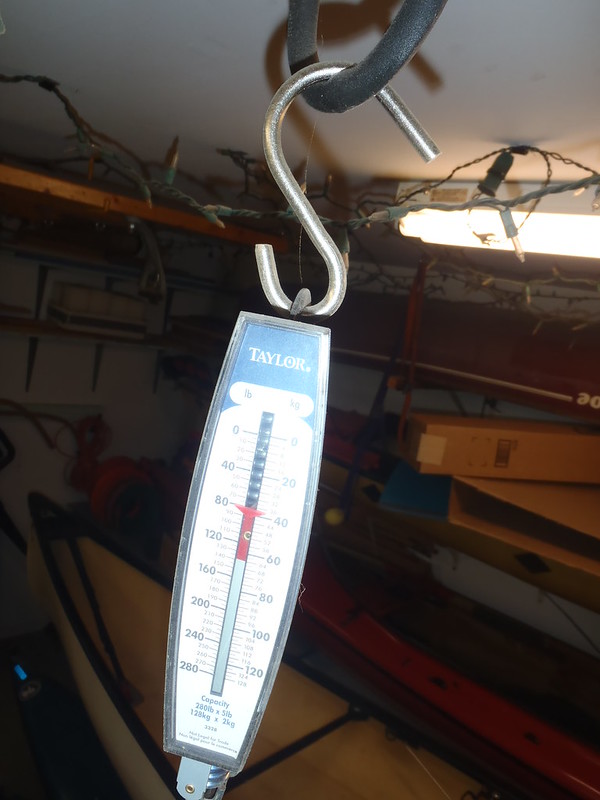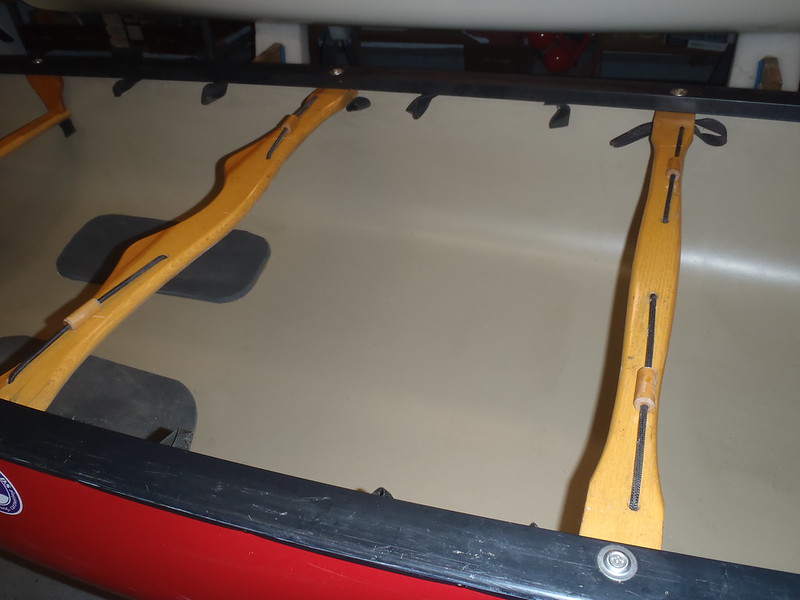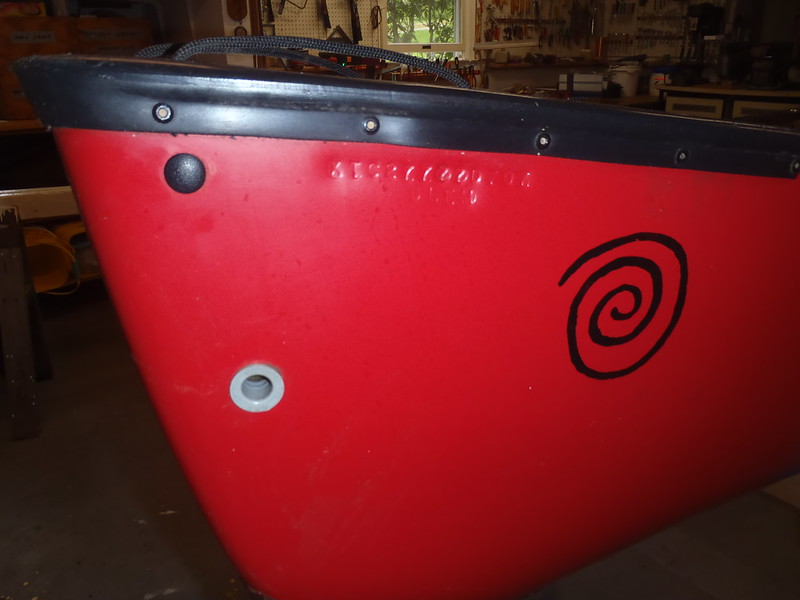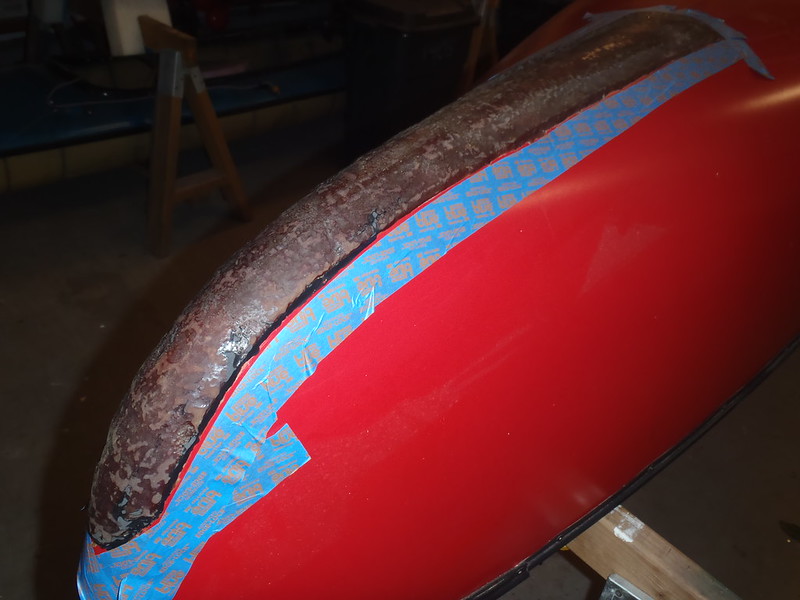G
Guest
Guest
It’s always fun to have a boat I worked on years ago return to the shop. A friend’s 2007 Old Town Appalachian reappeared a couple days ago. I haven’t seen that canoe since we did some custom outfitting on it 10 years ago.
Catalog page 4, still one of OT’s downriver winners in RX, along with the solo Cascade.
https://www.oldtowncanoe.com/sites/oldtowncanoe_site/files/old_town_2010_product_guide.pdf
First step was to wash it. Eh, scrub it; in 10 years of hanging largely unused it a shuttered barn it had gotten filthy, with an inch of encrusted dust and mouse crap deposited atop.
I learned some things even cleaning it up. Despite hanging in the barn dark for a decade the cheap Home Depot Poly line had degraded to dust. Even the float bag lacing and webbing straps were unworkably stiff when I removed them (I’ll soak them to see if they return to viability). It’s not just UV exposure; time waits for no rope, line or webbing.
I am more convince than ever to not leave good line, cord or webbing on a canoe, no matter how stored.
 P5260004 by Mike McCrea, on Flickr
P5260004 by Mike McCrea, on Flickr
Second step, weigh the beast; I didn’t have a hanging scale 10 years ago. Wish I had. I remembered that the Appy was a beast from the get go, and even using a portage cart to haul it into the shop realized that I hadn’t gotten any stronger in the interim. The Appalachian was an OT Blem, without any visible blemish.
 P5250002 by Mike McCrea, on Flickr
P5250002 by Mike McCrea, on Flickr
The “blem” is that it weighs 80 freaking lbs. OT specs it at 67 lbs. I know we didn’t add anywhere close to 13 lbs of outfitting weight to that canoe, I’ve weighed similar outfitting before and after. Even post Uni-Royal that is some beefy Royalex. Lifetime Royalex, or at least as long into life as you can tote an 80 canoe.
I had forgotten the very customized outfitting on the Appy. We did a really nice job on that canoe.
All the usual stuff, uncloggable ½” drain holes & painter keeper bungee on the decks, and thwart bungees for spare paddle grasp and misc hat/glasses/map keepage, vinyl pad D-rings for float bags or gear.
 P5260019 by Mike McCrea, on Flickr
P5260019 by Mike McCrea, on Flickr
 P5260020 by Mike McCrea, on Flickr
P5260020 by Mike McCrea, on Flickr
Custom “half-truss” drops replacing the flimsy OT dowel drops.
 P5260006 by Mike McCrea, on Flickr
P5260006 by Mike McCrea, on Flickr
Perimeter webbing loop tie downs under the inwale for gear or float bags; bow and stern or tandem center bags.
 P5260007 by Mike McCrea, on Flickr
P5260007 by Mike McCrea, on Flickr
Kneeling pads (uni-directional for tandem or bow backwards soloing)
 P5260010 by Mike McCrea, on Flickr
P5260010 by Mike McCrea, on Flickr
Appy friend only paddles on his right hand side when heeled over bow backwards solo, so some padding all the way up the chines to the inwale on that side for knee comfort.
 P5260012 by Mike McCrea, on Flickr
P5260012 by Mike McCrea, on Flickr
We even caplugged the original painter holes and installed sealed DIY tug eyes 5” lower on the stems, nearer the cutwater for lining purposes (flanged electrical fittings & pieces of hose, a dollar’s worth of parts and some epoxy).
 P5260015 by Mike McCrea, on Flickr
P5260015 by Mike McCrea, on Flickr
 P5260017 by Mike McCrea, on Flickr
P5260017 by Mike McCrea, on Flickr
The Appalachian returned to the shop with a single request; that I try to chisel or grind off the ugly kevlar felt skid plates.
Appy friend had installed an Old Town kev felt and urethane skid plate kit. Horribly installed, he used every ounce of urethane resin, did not bevel down the edges and laid a single sheet of wax paper over the wet resin, creating wrinkles, crinkles, dimples and creases. The rough terrain of ¼” thick resin (lots of resin left, just smear it on as a topcoat) made for the ugliest skid plate I had ever seen.
10 years ago, in an effort to reduce the obscene fuglieness of that surface mess, I had belt sanded down to fuzz and recoated both skid plates with tinted epoxy. Smoother, but still wavy, drippy edged from the initial urethane application.
 P5260024 by Mike McCrea, on Flickr
P5260024 by Mike McCrea, on Flickr
 P5260025 by Mike McCrea, on Flickr
P5260025 by Mike McCrea, on Flickr
Thanks to Doug and Jish it was easy to conclude that chiseling/grinding off was those intact if ugly skid plates is not worth the effort, especially if the end result is reinstalling another (better laid, pigmented and peel plied) kevlar felt skid plate to cover the removal damage and crusty residue left behind on the hull.
Even after that initial round of de-fuglifaction sanding and top epoxying the existing skid plates are still thick and wobbly edged, if at least smoother. Best I can do as a second effort is sand them a down a bit more, straighten up the wobbly drip edges and try to soften the abrupt transition edges.
First step, fairing down the edges that still stand tall and proud with a bead of G/flex, thickened with colloidal silica and graphite powder, so that raised lip doesn’t catch a rock and lift, and evening up the wobbly dips and drips into a straighter edge line while I’m at it.
Time to clamp the Appalachian over on its side for a thickened bead of epoxy to fill in along the proud edges. One side at a time, so the raised edge holds the bevel bead.
 P5260026 by Mike McCrea, on Flickr
P5260026 by Mike McCrea, on Flickr
 P5270028 by Mike McCrea, on Flickr
P5270028 by Mike McCrea, on Flickr
Once that edge bead sets up I’ll trim them up and recoat them overall with straight G/flex and graphite powder, taped out just past the wobbly drippy edge for a straighter skid plate line.
Catalog page 4, still one of OT’s downriver winners in RX, along with the solo Cascade.
https://www.oldtowncanoe.com/sites/oldtowncanoe_site/files/old_town_2010_product_guide.pdf
First step was to wash it. Eh, scrub it; in 10 years of hanging largely unused it a shuttered barn it had gotten filthy, with an inch of encrusted dust and mouse crap deposited atop.
I learned some things even cleaning it up. Despite hanging in the barn dark for a decade the cheap Home Depot Poly line had degraded to dust. Even the float bag lacing and webbing straps were unworkably stiff when I removed them (I’ll soak them to see if they return to viability). It’s not just UV exposure; time waits for no rope, line or webbing.
I am more convince than ever to not leave good line, cord or webbing on a canoe, no matter how stored.
 P5260004 by Mike McCrea, on Flickr
P5260004 by Mike McCrea, on FlickrSecond step, weigh the beast; I didn’t have a hanging scale 10 years ago. Wish I had. I remembered that the Appy was a beast from the get go, and even using a portage cart to haul it into the shop realized that I hadn’t gotten any stronger in the interim. The Appalachian was an OT Blem, without any visible blemish.
 P5250002 by Mike McCrea, on Flickr
P5250002 by Mike McCrea, on FlickrThe “blem” is that it weighs 80 freaking lbs. OT specs it at 67 lbs. I know we didn’t add anywhere close to 13 lbs of outfitting weight to that canoe, I’ve weighed similar outfitting before and after. Even post Uni-Royal that is some beefy Royalex. Lifetime Royalex, or at least as long into life as you can tote an 80 canoe.
I had forgotten the very customized outfitting on the Appy. We did a really nice job on that canoe.
All the usual stuff, uncloggable ½” drain holes & painter keeper bungee on the decks, and thwart bungees for spare paddle grasp and misc hat/glasses/map keepage, vinyl pad D-rings for float bags or gear.
 P5260019 by Mike McCrea, on Flickr
P5260019 by Mike McCrea, on Flickr P5260020 by Mike McCrea, on Flickr
P5260020 by Mike McCrea, on FlickrCustom “half-truss” drops replacing the flimsy OT dowel drops.
 P5260006 by Mike McCrea, on Flickr
P5260006 by Mike McCrea, on FlickrPerimeter webbing loop tie downs under the inwale for gear or float bags; bow and stern or tandem center bags.
 P5260007 by Mike McCrea, on Flickr
P5260007 by Mike McCrea, on FlickrKneeling pads (uni-directional for tandem or bow backwards soloing)
 P5260010 by Mike McCrea, on Flickr
P5260010 by Mike McCrea, on FlickrAppy friend only paddles on his right hand side when heeled over bow backwards solo, so some padding all the way up the chines to the inwale on that side for knee comfort.
 P5260012 by Mike McCrea, on Flickr
P5260012 by Mike McCrea, on FlickrWe even caplugged the original painter holes and installed sealed DIY tug eyes 5” lower on the stems, nearer the cutwater for lining purposes (flanged electrical fittings & pieces of hose, a dollar’s worth of parts and some epoxy).
 P5260015 by Mike McCrea, on Flickr
P5260015 by Mike McCrea, on Flickr P5260017 by Mike McCrea, on Flickr
P5260017 by Mike McCrea, on FlickrThe Appalachian returned to the shop with a single request; that I try to chisel or grind off the ugly kevlar felt skid plates.
Appy friend had installed an Old Town kev felt and urethane skid plate kit. Horribly installed, he used every ounce of urethane resin, did not bevel down the edges and laid a single sheet of wax paper over the wet resin, creating wrinkles, crinkles, dimples and creases. The rough terrain of ¼” thick resin (lots of resin left, just smear it on as a topcoat) made for the ugliest skid plate I had ever seen.
10 years ago, in an effort to reduce the obscene fuglieness of that surface mess, I had belt sanded down to fuzz and recoated both skid plates with tinted epoxy. Smoother, but still wavy, drippy edged from the initial urethane application.
 P5260024 by Mike McCrea, on Flickr
P5260024 by Mike McCrea, on Flickr P5260025 by Mike McCrea, on Flickr
P5260025 by Mike McCrea, on FlickrThanks to Doug and Jish it was easy to conclude that chiseling/grinding off was those intact if ugly skid plates is not worth the effort, especially if the end result is reinstalling another (better laid, pigmented and peel plied) kevlar felt skid plate to cover the removal damage and crusty residue left behind on the hull.
Even after that initial round of de-fuglifaction sanding and top epoxying the existing skid plates are still thick and wobbly edged, if at least smoother. Best I can do as a second effort is sand them a down a bit more, straighten up the wobbly drip edges and try to soften the abrupt transition edges.
First step, fairing down the edges that still stand tall and proud with a bead of G/flex, thickened with colloidal silica and graphite powder, so that raised lip doesn’t catch a rock and lift, and evening up the wobbly dips and drips into a straighter edge line while I’m at it.
Time to clamp the Appalachian over on its side for a thickened bead of epoxy to fill in along the proud edges. One side at a time, so the raised edge holds the bevel bead.
 P5260026 by Mike McCrea, on Flickr
P5260026 by Mike McCrea, on Flickr P5270028 by Mike McCrea, on Flickr
P5270028 by Mike McCrea, on FlickrOnce that edge bead sets up I’ll trim them up and recoat them overall with straight G/flex and graphite powder, taped out just past the wobbly drippy edge for a straighter skid plate line.



